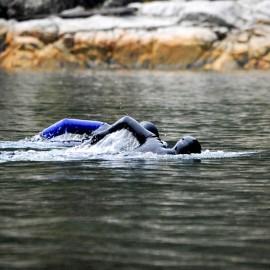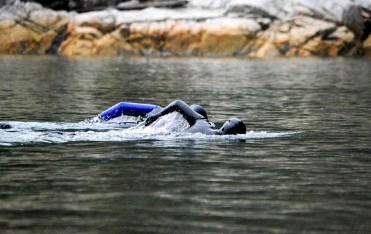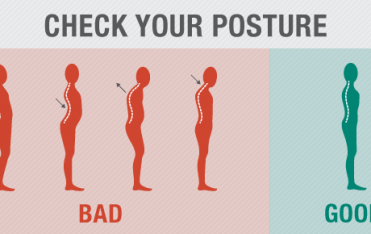With our local waters starting to warm up, many a sea-swimmer will be thinking about taking their first dip of 2016. And from thereon, many will be swimming regularly in preparation for the pier to pier and Brownsea Island swims.
Swimming is an excellent mode of cardiovascular conditioning, it also increases muscle strength and tone and improves stamina. Regular swimming, especially over long distances, will make you stronger and fitter, because of this, many athletes use it as a cross training tool to develop stamina, without the impact stress of other modes of exercise. Open-water swimming demands some additional skills to pool swimming – beyond adjusting to the water temperature, such as staying orientated, adapting to breathing in swell, and adjusting buoyancy in salt water, it also often offers different levels of resistance and intensity as a result of currents and tides.
Although the human body acclimatises to cold water well, it can take its toll on muscle efficiency and makes it more likely for the muscles to stiffen even over shorter training distances and importantly during races as fatigue sets in. Sports Massage Therapy with Fit2you can help both prepare the muscles pre-swim and also aid their recover post-training/race.
Freestyle or front crawl is one of the most popular swimming strokes used in training as it’s powerful and efficient. It uses muscles of the forearm, upper arm and shoulder, front of neck, the whole of the torso (front and back and sides!), glutes and legs – from hip to foot. It really is a whole body workout. Regular Sports Massage will help swimmers of any level prepare, train and race consistently, and this approach is entirely transferable to triathletes and other endurance athletes and those whose sport takes place out in the elements where there is a risk of exposure.
It is generally the arms that are put under greatest stress, particularly when swimming freestyle, which is the stroke of choice for most sea-swimmers. Freestyle requires repetitive internal (forward) rotation of the arms under load (i.e. the resistance of the water), and there is a tendency for the medial (inward) rotators to become shortened and stronger relative to the antagonistic lateral (outward) shoulder rotators. Sports Massage can help stretch the tight muscles of the chest, medial shoulder rotators and lower back; and at Fit2you we’ll also prescribe functional and corrective exercise to address the often-associated weakness in rotator cuff muscles, scapular stabilizers and lower abdomen.
Many people overlook the importance of the trunk for an efficient swim stroke and as many of us have an improperly conditioned core (abdominals and low/mid back), this can be the weak link – as the torso muscles fatigue, the pelvis begins to sag, creating drag in the water. Good core engagement, as the leading arm pulls through the water, helps rotate your body and encourages you to be as streamlined as possible, this helps maintain propulsion and prevents sagging at the middle. Unwanted drag from premature sagging is often a function of swimmers training the wrong abdominal muscles. While crunches which work the rectus abdominis (the outer layer of abdominal muscles) may help create that much-desired six-pack, the rectus abominis, being predominantly fast twitch muscle, is best suited for short bursts of work, and is not designed to support and stabilize the spine and limbs for extended periods of time, as is required in distance swimming. Focusing on this also overlooks other key muscles such as the obliques, which are prime movers (in rotation and lateral flexion) as well as stabilisers. To improve the engagement and function of the core stabilisers, you must train your trunk stabilisers, essentially your transverse abdominis and internal obliques. Pilates and similar exercises performed supine (on your back), prone (on your front) and four-point kneeling are excellent ways to achieve this. Fit2you provides one-to-one home and work place Pilates and Personal Training and also offers Pilates classes available to the public.
So, whatever level of swimmer you are, Fit2you Personal Training and Sports Massage Therapy can offer significant benefits. As training frequency and length increase, often so do the aches and pains. Adding Sports Massage to your programme increases the blood flow to the muscles, speeding up recovery thereby improving your performance. It will relieve muscle spasms, alleviate soreness and help prevent niggles turning into injury. Sports Massage can improve the range of motion at the shoulder and help injured muscles regain strength and accelerate their healing process; it will also:
– Help enhance body awareness
– Flush out toxins that cause muscle stiffness and soreness
– Identify problem areas before they develop into injuries
– Address trigger points, ‘knots’ (soft tissue adhesions) and scar tissue caused by overuse and injury, ultimately helping the muscles contract and release more effectively
– Relax and stretch muscles, restoring suppleness and improving range of motion
For serious swimmers, regular maintenance sports massage will help me recognise areas of biomechanical stress and muscle imbalance and allow us to address these through massage and corrective exercise thereby preventing further problems occurring and enabling you to adapt to higher levels of stress and optimise your performance overall.
Contact Jo on 07931 329552 or jo@fit2you.com for a free consultation.



